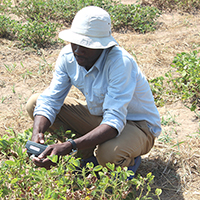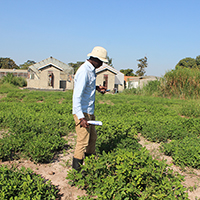Commercially available high-tech sensors can give farmers more information about the overall health of a crop, showing a clearer picture of how widely disease or drought is stressing the plants. That information empowers the farmer to make better decisions about when to invest in inputs and interventions to maximize yield.
But those same sensors can help plant breeders more quickly and objectively to assess the phenotypic characteristics of a particular variety, enabling the breeder to work quicker to develop varieties with resiliency traits.
A project under the Feed the Future Innovation Lab for Peanut headquartered at the University of Georgia is using inexpensive, handheld sensors to phenotype hundreds of peanut lines that were genotyped under a different project.
The devices – including a refractometer, a handheld NDVI gauge, an infrared thermometer, chlorophyll and photosynthesis meters, RGB camera, and a chlorophyll fluorometer – are relatively inexpensive, but measure physiological aspects of the plant more accurately than a person can with visual observations.
“We want to achieve two things,” said project lead scientist Maria Balota, a plant physiologist based at the Virginia Tech Tidewater Agricultural Research and Extension Center in Suffolk, Virginia. “First, we want to increase the number of (data) screenings that a breeder can have in a certain amount of time. They are not so laborious to do as with visual ranking.
“And, secondly, to increase the accuracy. If you have three people doing visual disease scoring, for example, human error is introduced. Using remote sensors, rather than visual ratings, minimizes the subjectivity.”
The high-throughput phenotyping project through the Peanut Innovation Lab includes three individual sub-projects in Africa – in Ghana, Senegal and Uganda – evaluating the same 200 peanut lines selected from a larger set of over 1200 lines from Africa.
While most of the remote-sensing work involves handheld devices, the project team plans to use drones in Senegal.
Across the three locations, Balota hopes the researchers identify physiological markers that are well associated with disease-resistance and other resilience features – phenotype markers to go along with the molecular markers from other projects.
“Instruments have the power and ability to do that,” she said.
Balota and her graduate research assistant at Virginia Tech, Sayantan Sarkar, have worked with many of the instruments in the past.
In April, Sarkar published some of his research in the Plant Phenome Journal, “High‐throughput measurement of peanut canopy height using digital surface models,” on using images from an RGB camera mounted on a drone to estimate the height of a crop. https://acsess.onlinelibrary.wiley.com/doi/full/10.1002/ppj2.20003
Scientists have used drones, or unmanned aerial vehicles, and photogrammetry to determine plant height in grain crops such as sorghum, wheat, barley and corn, but the algorithms are more difficult with shorter plants, like peanut.
Sarkar also is using RGB photos to estimate above-ground biomass and leaf area index remotely from drone images.
Remote sensing can’t reliably predict yield, since peanuts grow out of sight, but factors that can be measured may hint at yield.
“With peanut, it is kind of difficult because the crop is in the ground, but for breeders, we are looking to identify physiological traits that can be connected to yield,” Balota said.
For example, cooler canopies seem to be related to higher yield, so how a plant builds a canopy under certain conditions may relate to yield potential.
“We also are looking at leaf color to estimate vigor,” she said. “Vigor is one of the traits that we are trying to pick up with devices.”
Most of the field work to date on the high-throughput phenotyping project has been done in Uganda, where Makerere University master’s student Ivan Chapu collected data last summer
The Uganda team has an ambitious plan for experiments in 2020, including trials in the field and one in a greenhouse to simulate drought.
“There's lots to love about the work,” said Chapu. “The challenge of doing something I had never done before is just interesting. I am learning new things every other day and I feel I am good at it.
“Then, the idea of knowing I am doing something that will help solve a big problem in the breeding process just keeps me going.”








